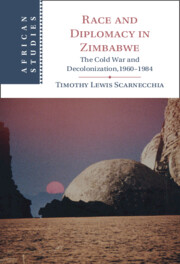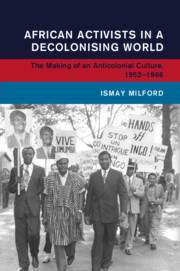109 results
Case Study 5.1 - Sovereign Debt Restructuring in Zambia
- from Section 5 - Finance
-
-
- Book:
- A Casebook on Chinese Outbound Investment
- Published online:
- 28 February 2025
- Print publication:
- 06 March 2025, pp 235-247
-
- Chapter
-
- You have access
- Open access
- HTML
- Export citation
The Colonial African: Godwin Mbikusita-Lewanika and His Struggle For and Against Zambian Nationalism
-
- Journal:
- The Journal of African History , First View
- Published online by Cambridge University Press:
- 21 November 2024, pp. 1-17
-
- Article
-
- You have access
- Open access
- HTML
- Export citation
An evaluation of African animal trypanosomiasis control strategies in remote communities of Eastern Zambia
-
- Journal:
- Parasitology / Volume 151 / Issue 11 / September 2024
- Published online by Cambridge University Press:
- 30 October 2024, pp. 1269-1276
-
- Article
-
- You have access
- Open access
- HTML
- Export citation
6 - Territorial Oppositions in African Politics
-
- Book:
- Inequality and Political Cleavage in Africa
- Published online:
- 18 April 2024
- Print publication:
- 25 April 2024, pp 168-194
-
- Chapter
- Export citation
Differences in germination traits of time-separated seed collections of dry forest species from Central Zambia and the potential role of climate
-
- Journal:
- Seed Science Research / Volume 34 / Issue 1 / March 2024
- Published online by Cambridge University Press:
- 24 April 2024, pp. 33-42
-
- Article
-
- You have access
- Open access
- HTML
- Export citation
The political economy of urban party switching in African elections: Evidence from Zambia
-
- Journal:
- The Journal of Modern African Studies / Volume 62 / Issue 1 / March 2024
- Published online by Cambridge University Press:
- 07 May 2024, pp. 79-103
- Print publication:
- March 2024
-
- Article
-
- You have access
- Open access
- HTML
- Export citation
Estimating minimum dietary diversity for children aged 6–23 months: a comparison of agreement and cost of two recall methods in Cambodia and Zambia
- Part of
-
- Journal:
- Public Health Nutrition / Volume 27 / Issue 1 / 2024
- Published online by Cambridge University Press:
- 22 January 2024, e79
-
- Article
-
- You have access
- Open access
- HTML
- Export citation
The politics of ‘institutionalising’ social protection in Africa: The retrenchment of social cash transfers in Zambia, 2015–2021
-
- Journal:
- Journal of International and Comparative Social Policy / Volume 39 / Issue 3 / November 2023
- Published online by Cambridge University Press:
- 04 January 2024, pp. 278-294
-
- Article
-
- You have access
- Open access
- HTML
- Export citation
Matsotsi: The Migrant Detective and the Postcolonial State
-
- Journal:
- Cambridge Journal of Postcolonial Literary Inquiry / Volume 11 / Issue 1 / January 2024
- Published online by Cambridge University Press:
- 15 December 2023, pp. 1-18
-
- Article
-
- You have access
- Open access
- HTML
- Export citation
Development studies meet Pierre Bourdieu: the case of Chinese Private FDI in Zambia
-
- Journal:
- The Journal of Modern African Studies / Volume 61 / Issue 4 / December 2023
- Published online by Cambridge University Press:
- 29 February 2024, pp. 521-543
- Print publication:
- December 2023
-
- Article
-
- You have access
- HTML
- Export citation
Sensory panel results of a dried fish powder supplement among caregivers and young children in Zambia
-
- Journal:
- Public Health Nutrition / Volume 27 / Issue 1 / 2024
- Published online by Cambridge University Press:
- 30 November 2023, e32
-
- Article
-
- You have access
- Open access
- HTML
- Export citation
Knowledge, attitude, and practices toward infection prevention and control among undergraduate pharmacy students in Zambia: findings and implications
-
- Journal:
- Antimicrobial Stewardship & Healthcare Epidemiology / Volume 3 / Issue 1 / 2023
- Published online by Cambridge University Press:
- 11 September 2023, e154
-
- Article
-
- You have access
- Open access
- HTML
- Export citation
4 - Confronting Economic Marginalization
-
- Book:
- Africa's Urban Youth
- Published online:
- 10 August 2023
- Print publication:
- 10 August 2023, pp 91-117
-
- Chapter
- Export citation
Political party ideology in Zambia: comparing the PF and the UPND on social welfare policies
-
- Journal:
- The Journal of Modern African Studies / Volume 61 / Issue 3 / September 2023
- Published online by Cambridge University Press:
- 10 August 2023, pp. 323-342
- Print publication:
- September 2023
-
- Article
-
- You have access
- Open access
- HTML
- Export citation
Chapter 2 - Figures of Extraction
-
- Book:
- China in Twentieth- and Twenty-First-Century African Literature
- Published online:
- 01 June 2023
- Print publication:
- 15 June 2023, pp 54-102
-
- Chapter
- Export citation
1 - Dress Practice as History
-
- Book:
- Dress Cultures in Zambia
- Published online:
- 20 April 2023
- Print publication:
- 27 April 2023, pp 5-18
-
- Chapter
- Export citation

Dress Cultures in Zambia
- Interwoven Histories, Global Exchanges, and Everyday Life
-
- Published online:
- 20 April 2023
- Print publication:
- 27 April 2023
3 - Liberation Struggles in Southern Africa
-
- Book:
- Race and Diplomacy in Zimbabwe
- Published online:
- 02 March 2023
- Print publication:
- 09 March 2023, pp 64-95
-
- Chapter
-
- You have access
- Open access
- HTML
- Export citation

Race and Diplomacy in Zimbabwe
- The Cold War and Decolonization,1960–1984
-
- Published online:
- 02 March 2023
- Print publication:
- 09 March 2023
-
- Book
-
- You have access
- Open access
- Export citation

African Activists in a Decolonising World
- The Making of an Anticolonial Culture, 1952–1966
-
- Published online:
- 02 March 2023
- Print publication:
- 09 March 2023

